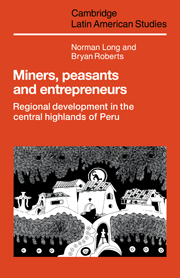Book contents
- Frontmatter
- Contents
- List of tables
- List of figures
- List of maps
- Preface
- 1 Regional development in an export economy
- 2 The development of a regional economy in the central highlands
- 3 The Mining Corporation and regional development
- 4 Class relations, local economies and large-scale mining
- 5 Highland puna communities and the impact of the mining economy
- 6 Migration and social differentiation amongst Mantaro valley peasants
- 7 Industrialization and the emergence of an informal regional economy
- 8 The village economy, agricultural development and contemporary patterns of social differentiation
- 9 Regional commitment among central highlands migrants in Lima
- 10 Confederations of households: extended domestic enterprises in city and country
- 11 Regional development in peripheral economies
- Notes
- Bibliography
- Index
- Titles in the series
6 - Migration and social differentiation amongst Mantaro valley peasants
Published online by Cambridge University Press: 07 May 2010
- Frontmatter
- Contents
- List of tables
- List of figures
- List of maps
- Preface
- 1 Regional development in an export economy
- 2 The development of a regional economy in the central highlands
- 3 The Mining Corporation and regional development
- 4 Class relations, local economies and large-scale mining
- 5 Highland puna communities and the impact of the mining economy
- 6 Migration and social differentiation amongst Mantaro valley peasants
- 7 Industrialization and the emergence of an informal regional economy
- 8 The village economy, agricultural development and contemporary patterns of social differentiation
- 9 Regional commitment among central highlands migrants in Lima
- 10 Confederations of households: extended domestic enterprises in city and country
- 11 Regional development in peripheral economies
- Notes
- Bibliography
- Index
- Titles in the series
Summary
Introduction
The intention of this chapter is to analyse how capitalist expansion in the central highlands has led to increased socio-economic differentiation within the villages of the Mantaro valley, examining closely the role which migration has played in this process. The hypothesis that capitalist expansion in the countryside results in increasing socio-economic differentiation has been much debated. Analysing the Russian experience, Lenin (1967) first argued that capitalism spread amongst the peasantry due to pressures from both external sources, acting through imbalanced exchanges, and internal sources, stemming from the accumulation of capital in the rural sector. As capitalist relations expanded so polarization occurred between richer peasants and landless labourers. Challenging this view, Chayanov (1966) maintained that the differentiation observed by Lenin in the rural areas was due to processes internal to the peasant economy and that this economy was highly resistant to capitalist penetration. This debate has continued with reference to both the Russian case and the experience of underdeveloped countries today (Goodman and Redcliff, 1981).
Integral to the differentiation debate is the concept of the peasant economy, distinguishable from the capitalist economy by its units of combined production and consumption, household labour and lack of market valuations (Shanin, 1973). The resilience of the peasant household and extended family, plus the mutual aid practices found amongst peasants, ranging from household exchanges to communal co-operation, result in a dogged resistance by peasants to the polarization process. It is this resilience that I examine in the following pages showing, however, that peasants become economically differentiated and yet absorbed within the capitalist economy in a variety of ways.
- Type
- Chapter
- Information
- Miners, Peasants and EntrepreneursRegional Development in the Central Highlands of Peru, pp. 107 - 139Publisher: Cambridge University PressPrint publication year: 1984
- 1
- Cited by



